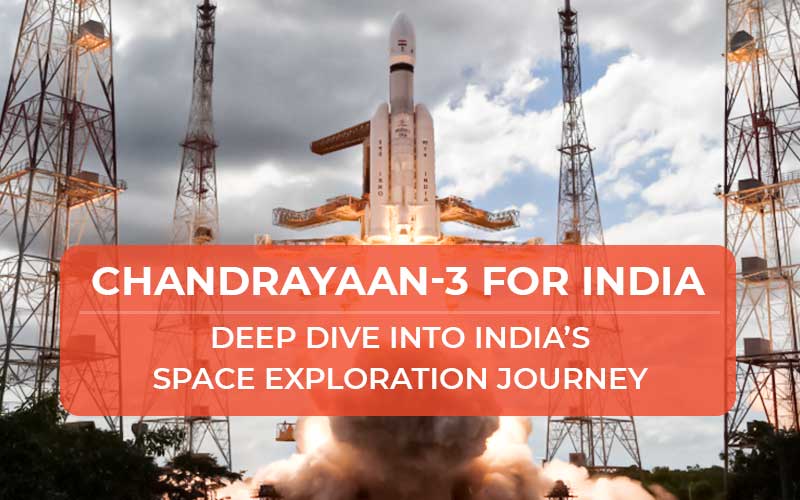
CHANDRAYAAN-3 FOR INDIA: DEEP DIVE INTO INDIA’S SPACE EXPLORATION JOURNEY
The Indian Space Research Organisation (ISRO) has
successfully launched its third lunar exploration mission Chandrayaan-3, which
lifted off from the Satish Dhawan Space Centre in Sriharikota, Andhra Pradesh
on 14th July, 2:35 PM. This momentous launch is a matter of national
pride for India, attracting millions of enthusiastic spectators from all around
the world and is currently the talk of all media outlets and social media
platforms.
Apart from the successful launch of Chandrayaan-3 and its
impact in the space exploration journey of India, it’s also remarkable how ISRO
has managed to execute its space programmes at a low budget. The Chandrayaan-2
launched in 2019 had a budget of Rs 978 crore. Following up with a higher
success rate and a much lower budget, India’s Chandrayaan-3 launch took off
successfully with a budget of just Rs 615 crore.
Looking back at the history of India’s space programme,
our first rocket was transported using a bicycle and the second one was
conveyed by means of a bullock cart. Given India’s financial limitations, a
significant investment in the space program becomes challenging. ISRO’s Founder
Vikram Sarabhai was aware that India was at a disadvantage when it came to its
socio-economic condition at the time. Therefore, he was driven by a vision to
register a milestone in India’s space programme that will open newer and
exciting avenues in the journey of India’s space exploration programmes and
strengthen the nation’s position along with it. Sarabhai was succeeded by
Satish Dhawan as ISRO’s Chairman, who took forward this vision amidst India’s
financial constraints. Prioritising the need to sustain ISRO’s mission in space
programmes despite the financial limitation, Dhawan decided to accept only 1
rupee as his salary.
Sarabhai’s legacy and Dhawan’s grit to take India into
newer heights of space exploration continues to fuel ISRO’s operations even
today. Today, India has prospered significantly in terms of its socio-economic
condition. Interestingly, ISRO’s space programmes continue to follow
economically viable routes even today. To put things into perspective, a space
programme run by ISRO costs almost 15 times less than that of NASA’s. Moreover,
ISRO’s operational rate today is so efficient and trustworthy that it has
received finances from 28 countries by successfully launching their satellites.
Back in 1969, when ISRO was first established in India,
it came off as a mockery to the world as NASA had already sent their first man
to the moon by then. Nonetheless, ISRO embarked on its journey and over time
went on to become a counterweight to China and even to the United States’ NASA.
What does Chandrayaan-3 mean to India?
The successful landing of Chandrayaan-3 would position
India as the pioneering country in explaining the origins of Earth and the
theory of evolution. A successful landing would enable detailed
investigations of the lunar surface and the transmission of valuable
information to ISRO. So far, only
three countries—America, Russia, and China—have achieved successful moon
landings. The south pole, targeted for the
Chandrayaan-3 landing, features a rugged surface with large craters. These
craters ensure that sunlight has never directly reached the surface, posing
challenges for a soft landing.
India’s Chandrayaan-3 is projected to make its landing
sometime around August 23, almost six weeks after the launch. The time taken is
significantly higher than previous missions launched by China, United States
and Russia, where the time taken by these nations ranged from around 36 hours
to a little over 4 days. On the contrary, the Chandrayaan-3 is not equipped
with a powerful enough rocket to be put on a direct path to the moon. But where
it lacks in infrastructure, ISRO makes up for it using a calculated approach
using a series of Earth orbits and engine burns to gradually increase the
spacecraft’s speed and position it for a lunar insertion. The multi-step
approach may be time-consuming but enables the use of a relatively less
powerful launch vehicle for the mission.
A successful soft landing by Chandrayaan-3 would
significantly elevate India's stature in the international space landscape,
potentially opening doors for collaborations with esteemed space agencies like
NASA. Furthermore, ISRO's space projects hold immense significance for national
security, as they also facilitate the effective monitoring of any untoward
disturbances caused by certain foreign nations.
In 2021, ISRO played a pivotal role in evacuating 1.15
million people during Cyclone Yaas in Odisha. Additionally, ISRO satellites
actively monitor earthquakes, cyclones, and floods.
Disclaimer: The opinions expressed in this article are those of the author's. They do not purport to reflect the opinions or views of The Critical Script or its editor.

Newsletter!!!
Subscribe to our weekly Newsletter and stay tuned.
















Related Comments